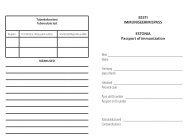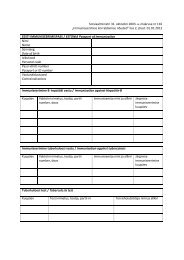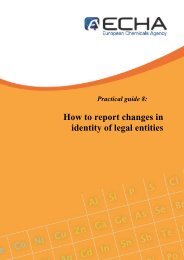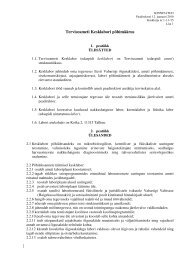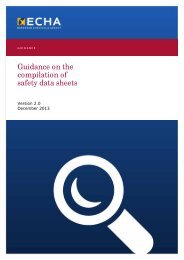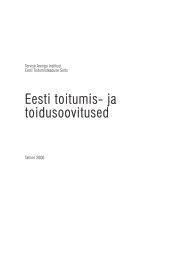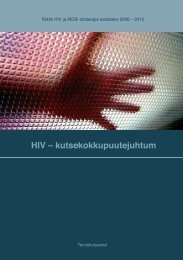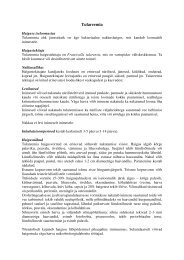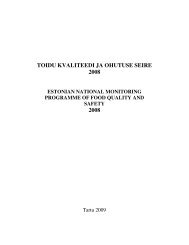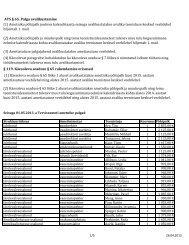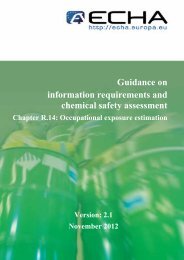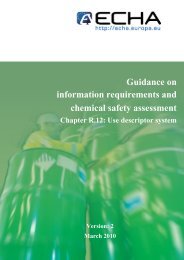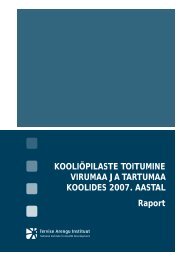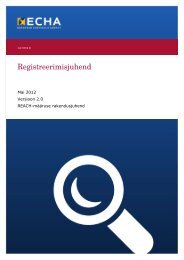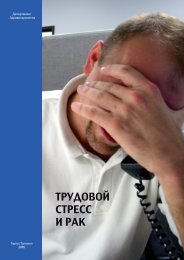Guidance on data sharing - ECHA - Europa
Guidance on data sharing - ECHA - Europa
Guidance on data sharing - ECHA - Europa
Create successful ePaper yourself
Turn your PDF publications into a flip-book with our unique Google optimized e-Paper software.
<str<strong>on</strong>g>Guidance</str<strong>on</strong>g> <strong>on</strong> <strong>data</strong> <strong>sharing</strong><br />
Versi<strong>on</strong> 2.0 April 2012<br />
49<br />
NB: In summary, Step 2 requires potential registrants (and potentially <strong>data</strong> holders) to (virtually) meet,<br />
discuss and agree <strong>on</strong> the main elements of the gathering of informati<strong>on</strong>, identificati<strong>on</strong> of informati<strong>on</strong><br />
needs, generati<strong>on</strong> of missing informati<strong>on</strong>, and <strong>sharing</strong> of the costs related to all registrati<strong>on</strong> activities.<br />
3.3.3.3 Step 3: Collecti<strong>on</strong> and Inventory creati<strong>on</strong> of informati<strong>on</strong> available to potential registrants<br />
In step 3, potential registrants should first organize themselves to complete the <strong>data</strong> collecti<strong>on</strong> phase, by<br />
collecting all informati<strong>on</strong> they have available individually. If literature searches have not been d<strong>on</strong>e individually<br />
in Step 1, these must be d<strong>on</strong>e jointly at this stage in order to gather all available informati<strong>on</strong>.<br />
To the extent that available <strong>data</strong> is not sufficient for registrati<strong>on</strong> purposes (Step 6 below), potential registrants<br />
must collect <strong>data</strong> available from (1) <strong>data</strong> holders, (2) other SIEFs and (3) outside the SIEFs. However,<br />
if the potential registrants know in advance, for example from previous c<strong>on</strong>tacts, that they do not have a<br />
complete <strong>data</strong> set with their own <strong>data</strong>, they may decide to c<strong>on</strong>tact <strong>data</strong> holders or other SIEFs early. Informati<strong>on</strong><br />
from other SIEFs can be obtained after requesting read–across from another substance.<br />
Collecting <strong>data</strong> available to potential registrants can be d<strong>on</strong>e in the form of a questi<strong>on</strong>naire structured<br />
according to Annexes VI to X of REACH which the lead registrant sends to all potential registrants and that<br />
is returned within the requested deadline. This questi<strong>on</strong>naire may also include a request to communicate the<br />
classificati<strong>on</strong> and labelling of the substance.<br />
In order to help participants review available <strong>data</strong> a form is proposed, as an example, in Annex 1.<br />
As the above <strong>data</strong> is being collected, it should be entered into a comm<strong>on</strong> inventory. This would best be in the<br />
form of a matrix which compares the <strong>data</strong> available for each end point (up to the highest t<strong>on</strong>nage threshold<br />
am<strong>on</strong>g potential registrants) with the <strong>data</strong> needs and identifies key elements for each study, including the<br />
identity of the <strong>data</strong> holder.<br />
To the extent that the literature search may require c<strong>on</strong>siderable time to be completed, it is recommended<br />
that potential registrants c<strong>on</strong>tinue their work and initiate Steps 4 and possibly 5 below without waiting for<br />
Step 3 to be completed.<br />
NB: In summary, Step 3 requires potential registrants to collect and create an inventory of all informati<strong>on</strong><br />
<strong>on</strong> the substance they have available within the SIEF. They may also c<strong>on</strong>sider at this stage <strong>data</strong> available<br />
to <strong>data</strong> holders, in other SIEFs and outside of the SIEFs, in particular in situati<strong>on</strong>s where potential<br />
registrants know they do not have a full <strong>data</strong> set for Registrati<strong>on</strong> purposes.<br />
3.3.3.4 Step 4: Evaluati<strong>on</strong> of available informati<strong>on</strong> within the SIEF<br />
The next step is for potential registrants to evaluate the <strong>data</strong> available <strong>on</strong> the substance to be registered.<br />
This step may be undertaken by the lead registrant, any other potential registrant, or a representative acting<br />
<strong>on</strong> behalf of all potential registrants.<br />
Essentially, for each endpoint, the following acti<strong>on</strong>s must be performed:<br />
• Assess the relevance, reliability, adequacy and fitness for purpose of all gathered <strong>data</strong> (for more details<br />
please c<strong>on</strong>sult the <str<strong>on</strong>g>Guidance</str<strong>on</strong>g> <strong>on</strong> informati<strong>on</strong> requirements for arriving at c<strong>on</strong>clusi<strong>on</strong>s <strong>on</strong> the hazard assessment<br />
and for risk characterizati<strong>on</strong>).



